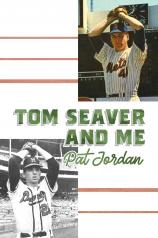Tom Seaver and Me
Review
Tom Seaver and Me
When I first started out as a newspaper reporter, after more than 20 years in public relations, I was constantly surprised when famous people were willing to talk with me, especially other writers.
A popular veteran sportswriter/author moved into our coverage area, and I was assigned to do a story on him. As someone relatively new to the profession, I was a bit intimidated. But he couldn’t have been nicer, and we developed a casual friendship over the next few years until his death from cancer.
It’s not quite the same scenario, but I can get a small sense of what it might have been like for Pat Jordan, a bonus baby back in the late 1950s, and Tom Seaver, “The Franchise” and Hall of Fame pitcher for the New York Mets (and a few other teams), who passed away at the end of August. Their almost 50-year friendship is the subject of Jordan’s latest book, TOM SEAVER AND ME, which was actually released several months prior to his pal’s demise.
"Jordan’s recollection of conversations is at once tender, funny and somewhat aggravating, bordering a bit on self-aggrandizement, reminding us that he’s special because he’s one of the few people who has that relationship with the superstar."
Jordan never really made it as a professional ballplayer; he washed up after a few disappointing minor league seasons. Like Seaver, who was a few years his junior, he was a pitcher, so they had that in common. When Jordan hung up his spikes, he picked up a pen and became a writer of some renown. He published two memoirs, A FALSE SPRING and THE SUITORS OF SPRING, on the agony and frustration of coming close but never quite making it, as many had expected.
Jordan has written other sports books, as well as a couple of detective novels, but he is mainly known for his work for magazines, notably Sports Illustrated, which was the “matchmaker,” if you will, between him and Seaver for a story back in 1971. It was two years after Seaver led the Mets to their unlikely World Championship over the Baltimore Orioles. Since they were close in age, it wasn’t surprising that Jordan would still feel a sense of competition, as evidenced in their one-on-one basketball games at a local Y in Greenwich, Connecticut, where Seaver lived with his picture-perfect wife, Nancy.
It’s not a reach to say that the game was the impetus of mutual respect and affinity that lasted for decades, although Jordan claims they were never “that close”:
“We didn’t have ‘the Seavers’ over for dinner, nor did they have ‘the Jordans’ over for dinner,” he writes in the prologue. “We didn’t take vacations together like close couples do….The four of us, talking, laughing, friends.”
In the pre-texting era, Jordan would occasionally pick up the phone after watching Seaver pitch a game, usually following a bad outing, pointing out a flaw or suggesting a tweak. As you might think, Seaver --- a proud and opinionated man --- didn’t always relish the shared opinion.
Jordan points out that Seaver was a perfectionist with flaws. The young pitcher worked hard on his image, as did his wife, which rubbed some people the wrong way. He was branded an intellectual because he liked fine wines, art, music and doing the New York Times crossword puzzle. And at a time when athletes were expected to do their jobs and keep their mouths shut, Seaver wasn’t shy about sharing his political views. This chafed not only his employers and older sportswriters, but some teammates as well.
Seaver was similarly outspoken when it came to how he was being underpaid in comparison with pitchers with less skill but better luck (this was right around the time when free agency was making inroads and salaries were beginning to take off). This eventually led to the “Midnight Massacre,” a series of trades that the Mets made to unload their malcontents. Seaver ended up with the Cincinnati Reds, and Jordan continued to keep in touch as Seaver returned briefly to the Mets before moving on to the Chicago White Sox and Boston Red Sox, where he ended his career in 1986.
The chapters cover specific years with Seaver as a player and in retirement. Since most readers know about his death from complications due to dementia, it’s a good bet that they can predict the final chapters will be hard going. Seaver knows he has problems stemming from the Lyme disease he contracted back east (by this time, he had purchased a vineyard in northern California that he took great delight in running himself), but the slow downward spiral is still hard to take. Jordan’s recollection of conversations is at once tender, funny and somewhat aggravating, bordering a bit on self-aggrandizement, reminding us that he’s special because he’s one of the few people who has that relationship with the superstar. He reminds the reader of his own shortcomings and disappointments, which make that unlikely connection all the more special.
There is repetition in several of their conversations, in recalling experiences shared and tacitly understood. And, sure enough, there are constant jibes between writer and subject, as the former claims several times that he threw harder. But that familiarity breeds understanding that those of us who have had longtime friends have been lucky to enjoy.
Reviewed by Ron Kaplan on October 9, 2020
Tom Seaver and Me
- Publication Date: May 26, 2020
- Genres: Memoir, Nonfiction, Sports
- Hardcover: 192 pages
- Publisher: Post Hill Press
- ISBN-10: 1642934615
- ISBN-13: 9781642934618




